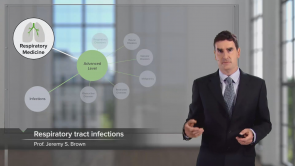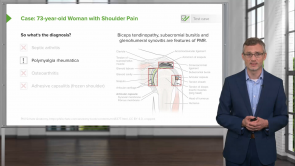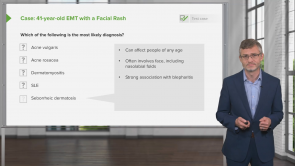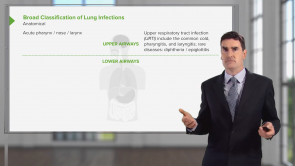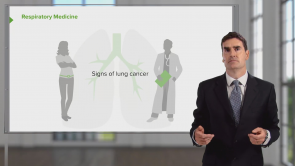Pneumonia: Diagnosis
Über den Vortrag
Der Vortrag „Pneumonia: Diagnosis“ von Jeremy Brown, PhD, MRCP(UK), MBBS ist Bestandteil des Kurses „Infections of the Respiratory Tract“.
Quiz zum Vortrag
Which of the following is NOT a reason to obtain a chest X-ray in a patient with dyspnea, asymmetrical crepitation, and dullness on chest percussion?
- To calculate the patient's CURB-65 score
- To identify consolidations
- To identify pleural effusions
- To exclude pulmonary masses
- To exclude uncomplicated pulmonary edema
Which of the following is NOT a common laboratory finding in a patient with pneumonia?
- Decreased C-reactive protein
- Decreased sodium
- Elevated WBC count
- Elevated urea and creatinine
- Decreased albumin
A patient presents with fever, chest pain, and difficulty breathing. Labs show markedly elevated WBC count, low serum albumin, elevated urea and creatinine, and elevated liver function tests. Chest X-ray appears clear. Which finding in the patient's initial evaluation does not fit with the diagnosis of pneumonia?
- Clear lung fields on chest X-ray
- High WBC count
- High ALT
- Low albumin
- High urea and creatinine
Which of the following is NOT a worrisome feature in the assessment of the severity of pneumonia?
- C-reactive protein < 40 mg/L
- Worsening consolidation
- Septicemia
- Presence of severe comorbidity
- Oxygen saturation < 92%
A 45-year-old male patient has been diagnosed with pneumonia. The patient is well oriented to time, place, and person. The patient's respiratory rate is 18 breaths per minute, blood pressure is 120/80 mm Hg, oxygen saturation is 95%, and urea level is 8 mmol/L. What is the next best step in management?
- Discharge with appropriate antibiotic therapy.
- Discharge with instructions for supportive care only (rest, hydration, etc)
- Admit and treat with broad-spectrum antibiotics.
- Admit to the intensive care unit for intubation.
- Observe the patient in the emergency department for 6 hours for deterioration in condition.
Which of the following does NOT indicate higher severity based on the CURB-65 scoring system for pneumonia?
- Respiratory rate < 30 breaths per minute
- Confusion
- Urea > 7 mmol/L (19 mg/dL)
- Diastolic BP < 60 mm Hg
- Age > 65 years
A 65-year-old man comes to the office with a 1-month history of chest pain and shortness of breath. The patient has bilateral crackles on examination and chest X-ray shows bilateral peripheral lung infiltrates with normal findings in central areas of the lungs. C-reactive protein is 230 mg/dL. The patient has been taking antibiotics for a month, but not responding to treatment. Which of the following is the most likely diagnosis?
- Pulmonary eosinophilia
- Lobar pneumonia
- Acute bronchitis
- Influenza
- Upper respiratory tract infection
A patient previously diagnosed with pneumonia presents post treatment with persistent signs and symptoms of septicemia. Based on the information from this lecture, what is the mortality percentage for patients with a similar presentation?
- 20%
- 10%
- 5%
- 50%
- 1%
Which of the following is TRUE about the CURB-65 score?
- The maximum CURB-65 score is 5.
- The risk of patient mortality increases as the CURB-65 score decreases.
- The CURB-65 score is the only method of assessing mortality in a patient with pneumonia.
- The CURB-65 score uses oxygen saturation as an important parameter in severity distinction.
- The CURB-65 score uses the same variables as the Pneumonia Severity Index (PSI).
What is the CURB-65 score for a 72-year-old man presenting with pneumonia, confusion, diastolic BP of 72 mm Hg, respiratory rate of 28 breaths per minute, and urea of 12.5 mmol/L?
- 3
- 2
- 4
- 5
- 6
Diese Kurse könnten Sie interessieren
Kundenrezensionen
5,0 von 5 Sternen
| 5 Sterne |
|
1 |
| 4 Sterne |
|
0 |
| 3 Sterne |
|
0 |
| 2 Sterne |
|
0 |
| 1 Stern |
|
0 |
Well-explained, well-organized, and easily comprehensible. It covers all the important information in detail, labs, DD, assessment of severity.

